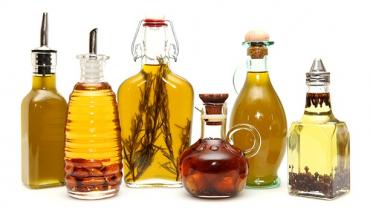
With all the buzz in the press lately about how we might have been misled about the dangers of dietary saturated fat and with new books supporting that perspective now is a good time for a refresher on fats. Having a good foundation of knowledge about fats will help you make sense of the sometimes sensationalist headlines the media uses to generate “likes” clicks and shares on social media but which are not always based on sound science.
For now let’s stick with the basics. When it comes to fats there are three main categories: saturated monounsaturated and polyunsaturated. All of them are important for good health. The differences between them are due to their chemical structure which affects how they act inside our bodies as well as how they fare when exposed to heat air and light such as when we coat a frying pan or skillet with them for cooking.
The scientists who study fats and oils (collectively called lipids) use the term “oil” to refer to lipids that are liquid at room temperature (like corn oil and canola oil) and “fat” when talking about ones that are solid (such as butter and lard). For simplicity’s sake let’s do like most of our grandmothers did and call them all “fats” differentiating only when necessary.
One key thing to keep in mind is that no source of fat—either plant or animal—is all saturated or all unsaturated. All fats and oils are combinations of different types of fatty acids. Even lard whose mere mentioning might make you think you can feel your arteries clogging at this very moment is actually higher in monounsaturated fatty acids than saturated. And of the monounsaturated fat that comprises lard over 91% of it is oleic acid the very same fatty acid that is widely regarded to be the reason why olive oil has such positive effects on heart health. Olive oil appears to be the only fat the seemingly contradictory nutritional “warring factions” all agree is good for us whether they’re vegetarian Paleo low-carb or simply focused on real whole unprocessed foods. So considering that lard is over 41% the same as olive oil and even our darling olive oil itself is about 14% saturated Chef Emeril Lagasse has been right all along: pork fat does rule!
This chart shows the percentages of the different kinds of fatty acids that make up various common fats and oils.
|
Type of fat or oil |
% Saturated |
% Monounsaturated |
% Polyunsaturated |
|
Coconut oil |
91 |
6 |
3 |
|
Butter |
66 |
30 |
4 |
|
Lamb tallow |
58 |
38 |
2 |
|
Palm oil |
51 |
39 |
9 |
|
Beef Tallow |
49-54 |
42-48 |
3-4 |
|
Lard |
44 |
45 |
11 |
|
Duck fat |
35 |
50 |
14 |
|
Chicken fat (schmaltz) |
31 |
49 |
20 |
|
Cottonseed oil |
29 |
18 |
52 |
|
Peanut oil |
16 |
56 |
26 |
|
Olive oil |
15 |
73 |
10 |
|
Soybean oil |
15 |
22 |
62 |
|
Sesame oil |
15 |
41 |
43 |
|
Corn oil |
14 |
27 |
59 |
|
Sunflower oil |
13 |
18 |
69 |
|
Grapeseed oil |
11 |
16 |
73 |
|
Safflower oil |
9 |
11 |
80 |
|
Flaxseed oil |
9 |
17 |
74 |
|
High oleic sunflower oil |
9 |
81 |
8 |
|
Canola oil |
7 |
65 |
28 |
Sources: USDA Agricultural Research Service National Nutrient Database forStandard Reference and Know Your Fats by Mary Enig PhD.
As you can see some of the fats we’re accustomed to hearing called “saturated”—like beef or pork fat—actually contain either more monounsaturated fatty acids or about the same amounts of saturated and monounsaturated. And two of the fats that are the most highly saturated don’t come from animal foods at all but from plants: coconut and palm oil!
So don’t be taken in by bogus headlines shouting about red meat and saturated fat or “vegetable oils” being entirely benign. The facts on fats are more complex than that and we can’t have an intelligent national discussion about truly nutritious food unless we have a good understanding of these issues.